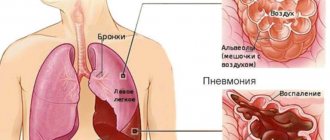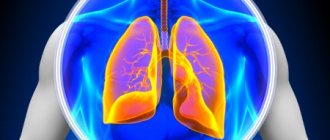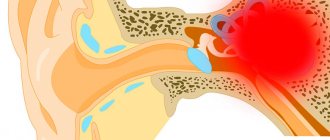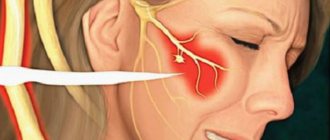Causes
Diseases that are accompanied by catarrhal syndrome belong to the group of acute otolaryngological infections. Most often, their main pathogens are various viruses, less often bacteria. The causes of catarrhal syndrome may be exposure to allergens and irritants of a cold nature. Very often the influence of various factors is expressed, for example, colds and viruses.
The main pathogens are considered to be viruses that have a high tropism towards certain parts of the respiratory canals.
Catarrhal phenomena
Catarrhal phenomena are a series of symptomatic signs that most often occur with colds and viral diseases. The main symptom of catarrh is inflammation of the mucous membranes, their swelling and hyperemia. Mostly such processes occur in the nasopharynx, upper respiratory tract, and conjunctivae of the eyes.
Catarrh manifests itself as lacrimation, runny nose, coughing, sneezing, and photophobia. Many diseases, both viral and bacterial or fungal infections, begin with such symptoms.
Types of catarrhal phenomena
The classification of this inflammation is based on which organ is affected.
- Conjunctivitis is a disease in which the pathogen affects the mucous membrane of the eyes, causing discomfort, a feeling of sand, itching, lacrimation, and fear of bright lighting.
- Rhinitis is inflammation of the nasal mucosa. Signs of the disease include copious discharge from the nasal passages of a mucous or purulent nature, nasal congestion, and difficulty breathing. This significantly worsens the quality of life of patients, their sleep is disturbed and during periods of wakefulness they are tied to a handkerchief.
- Pharyngitis is a process in which inflammation is localized in the throat, its walls become red and swollen, and follicles with an accumulation of pathological fluid may appear. Patients complain of severe soreness and scratching in the throat, and an obsessive dry cough.
- Tonsillitis is an inflammation of the tonsils, which causes severe pain in the throat when swallowing or even talking and enlargement of nearby lymph nodes.
- Laryngitis - with this phenomenon, the larynx becomes inflamed, which is manifested by changes, hoarseness or even loss of voice, paroxysmal hacking cough, especially at night.
- Tracheitis - with this disease, pathological processes develop in the trachea. Patients experience pain in the upper chest and suffer from a dry or wet painful cough.
- Bronchitis is characterized by inflammation in the area of the bronchial tree, swelling, which can result in obstruction and impairment of respiratory functions. Manifested by harsh or wheezing breathing, dry cough or cough with sputum, pain in the chest and wheezing of various sizes audible through a stethoscope.
- Pneumonia, a disease of the lung tissue of inflammatory nature, is manifested by serious breathing problems, severe intoxication, wheezing, and the likelihood of severe complications.
Catarrhal phenomena primarily accompany the onset of diseases of viral etiology:
Diseases caused by bacteria and protozoa can also have several catarrhal symptoms in the clinical picture - these are banal sore throats, sinusitis, sinusitis, and even diseases of the gastrointestinal tract and musculoskeletal system.
Catarrhal phenomena are constant companions of allergic diseases: seasonal hay fever, hay fever, food intolerance. The reason for their occurrence is the appearance of irritating agents in nature or human everyday life: pollen, food or chemical allergens.
Diagnostics
Catarrhal phenomena occur in many diseases. Diagnosis of the disease in which they are observed is based on an analysis of the patients’ lives, the clinical picture of the disease, examination, and data from laboratory and instrumental studies.
When contacting a doctor, it is important to provide him with complete information about the disease, describe the onset and symptoms of the disease, and pay attention to your chronic ailments.
For successful treatment of any disease, it is important to determine the nature of the pathogen that caused it. Tests of blood and other body fluids can identify bacteria, viruses and other microorganisms that provoke the development of the disease. If the disease is of an allergic nature, a series of samples and tests are carried out to determine the irritating agent.
The first thing the attending physician will suspect in case of catarrhal symptoms is ARVI, acute respiratory infections or influenza.
Depending on the diagnosis and test results, the patient will be prescribed treatment or will continue further examination to determine the cause of the disease.
If the clinical picture and nature of the disease are unclear, this may take a long time, but adequate treatment is impossible without making a correct diagnosis.
Sometimes, to identify the cause of the chronic course of catarrhal phenomena, it is important to establish a connection with the living conditions of patients. Long-term stay in damp, poorly ventilated rooms, where the fungus freely multiplies on the walls, contributes to the contamination of the mucous membranes of the hosts with their spores, which can cause “unreasonable” prolonged runny nose, cough, and lacrimation.
What causes the disease
Clinical forms of catarrhal syndrome include the following manifestations:
• Acute rhinitis is an inflammation of the mucous membrane in the nasal cavity. Characteristic symptoms include sneezing with mucus discharge from the nose and impaired nasal breathing. The process of mucus draining down the back of the throat usually causes a cough.
• Pharyngitis is an inflammation of the pharyngeal mucosa. It is characterized by a sudden onset of tickling sensations with a dry throat, as well as pain when swallowing. Qatar of the upper respiratory tract may be accompanied by fever, weakness, and refusal to eat.
• Tonsillitis is expressed by local changes in the tonsils, which have a bacterial (often streptococcal) or viral etiology. This condition is characterized by intoxication with hyperemia and swelling of the tonsils, as well as the palatine arches, uvula, and posterior pharyngeal wall. May be accompanied by loose overlay in gaps.
• Laryngitis is an inflammation of the larynx that involves the vocal cords and subglottic space. The first symptoms in this case are a dry and barking cough with hoarseness.
• Epiglottitis is an inflammation of the epiglottis with a characteristic and pronounced disturbance in breathing.
• Tracheitis. The disease is an inflammatory process of the tracheal mucosa. Symptoms in this situation manifest themselves in the form of a dry cough. Most often, with infectious diseases, catarrhal syndrome is observed.
• Bronchitis. This disease affects the bronchi of any caliber. The main symptom is cough. At the very beginning of the disease, the cough is usually dry, but after a few days it becomes wet and is characterized by an increase in the amount of sputum, which is often mucous in nature. In the second week of the disease, sputum coughed up may acquire a greenish color due to an admixture of fibrin. The cough can persist for fourteen days, and sometimes up to one month. Cough, as a rule, is delayed in the presence of adenoviral, respiratory syncytial, mycoplasma and chlamydial factors. We will consider the symptoms and treatment of acute respiratory infections and influenza in adults below.
Distinctive features of Qatar
With catarrh, not only the inflammatory process and the production of pathological mucus develop. In ordinary sputum there is liquid secreted from the capillaries, exudate produced by the glands of the mucous membrane. In catarrh, the sputum contains cells that are separated from the ciliated epithelium.
Exudative deposits vary in nature, depending on their composition:
- mucous membranes – transparent, viscous;
- serous - white or milky in color, with a yellow or gray tint;
- mucopurulent or purulent - yellow, green discharge, unpleasant odor;
- fibrinous - mucus contains epithelial films, they are in close contact with the membrane and, when released, injure it, which may be accompanied by capillary bleeding.
Usually, with catarrh, the upper layer of the epithelium is torn off, the rest of the tissue remains intact. With normal inflammation, regeneration occurs quickly. But after catarrh, the restoration of destroyed cells takes longer. This is due to the fact that in pathology, biochemical intracellular processes are disrupted, and the cells cannot complete the full development cycle.
Acute catarrh quickly resolves, and the mucous membrane takes on a normal physiological appearance. In chronic cases, the damage is more significant. The mucous membrane thickens, an infiltrate forms, and swelling develops. The epithelium becomes pale, acquires a gray or gray-black tint.
Signs
What are the main symptoms of the disease? When examining patients with catarrhal syndrome, the following phenomena are usually observed:
• The nasal mucosa appears swollen and hyperemic. Often it can be covered with crusts.
• Tracheitis can manifest itself as unpleasant sensations in the form of pain behind the sternum, cough of varying intensity, which can be dry or with some sputum.
• Pharyngitis may be accompanied by a sore throat and difficulty swallowing.
• The pharyngeal mucosa is thickened and hyperemic.
• The main manifestation of laryngitis is a change in the timbre of the voice, hoarseness occurs, and speech may become difficult to distinguish. In rare cases, the voice disappears completely.
Qatar of the upper respiratory tract can spread to the lower regions. In this case, patients develop acute tracheobronchitis. To fully characterize catarrhal syndrome in infectious diseases, a detailed examination of the pharynx is considered informative. An important condition is directional lighting through the use of a reflector or table lamp. The symptoms of catarrhal syndrome are very unpleasant.
Catarrhal phenomena: symptoms of catarrh
Catarrhal phenomena are various symptomatic signs that occur mainly with viral or colds.
The main symptom of catarrh is swelling, inflammation and hyperemia of the mucous membranes. Most often, such processes occur with influenza, colds, and acute respiratory diseases.
The causative agents of catarrh are bacteria and adenoviruses. Once in the body, they cause many diseases.
How do catarrhal processes occur in the upper respiratory tract?
Signs of catarrhal phenomena of the upper respiratory tract are characterized by inflammation of the bronchial mucosa, as a result of which sputum begins to accumulate in large quantities, a cough and runny nose appear. Not only a specific area is affected, but also those located next to it, since the mucous membrane of the respiratory tract is a single whole.
Catarrhal phenomena of the upper respiratory tract, depending on the location of the infection, are as follows:
- rhinitis;
- tonsillitis;
- laryngitis;
- sinusitis (frontal sinusitis, sinusitis);
- pharyngitis.
What causes catarrhal diseases?
People of any age are exposed to catarrhal phenomena, but most often pathological processes develop in older people due to reduced immunity.
Catarrhal processes can occur if a person’s work is associated with harmful substances. Chemical elements negatively affect the respiratory tract, which leads to catarrhal changes. Qatar can also occur due to hypothermia, in damp weather, or during sudden temperature changes.
In addition, predisposition to diseases plays an important role. The appearance of the disease can be triggered by the anatomical features of the human body, abuse of alcohol or tobacco products, poor environmental conditions, acute or chronic diseases, and low immunity.
Symptoms of catarrh
The general symptoms of all catarrhal processes are almost the same. These include:
- labored breathing;
- temperature increase;
- lack of appetite;
- body aches, general malaise;
- feeling of dry mouth;
- headache;
- dry cough.
Can catarrhal symptoms occur without fever? This is quite possible and happens if the disease is mild, the patient has reduced immunity, and also with some viral diseases (for example, rhinovirus infection).
How are catarrhal processes diagnosed?
Catarrhal phenomena accompany a large number of diseases. During a visit to the doctor, he must provide a complete medical history and describe its symptoms. For treatment to be successful, it is important to identify the pathogen that caused the disease.
It is imperative to donate blood and other body fluids for analysis, which will identify viruses, bacteria and other microorganisms that caused the disease.
If the disease is allergic in nature, then a series of tests and samples are carried out to determine the irritating agent.
In the presence of catarrhal symptoms, the doctor will first of all suspect acute respiratory infections, acute respiratory viral infections or influenza. If the results have been obtained and the correct diagnosis has been established, the patient is prescribed appropriate treatment. If the nature of the disease is unclear, adequate treatment is possible only after a correct diagnosis has been established.
In some cases, in order to establish the exact cause of the chronic course of catarrhal phenomena, the connection with the patient’s living conditions is studied.
A long-lasting runny nose, constant lacrimation and cough can occur after many years of living in damp and poorly ventilated rooms, as a result of which fungus begins to multiply intensively on the walls, the spores of which settle on the human mucous membrane.
Catarrhal symptoms with influenza
Catarrhal processes with influenza can occur both at the very beginning of the disease and after a day or more. The patient begins to have a sore throat, pain occurs when swallowing, the nasal mucosa swells, a runny nose appears, cough, sometimes with sputum, the voice becomes hoarse.
A runny nose at the beginning of the disease is accompanied by serous-mucous discharge, and subsequently it becomes thick mucopurulent. Sometimes nosebleeds occur. The tonsils, soft palate, uvula, arches, and posterior wall of the pharynx swell and often acquire a cyanotic tint.
Laryngitis, tracheobronchitis, laryngotracheitis, and bronchitis may occur.
The chills that accompany the disease are not always severe. At first it is quite small, and sometimes completely absent. Dizziness occurs almost immediately and can even occur in a lying position.
Treatment of catarrhal diseases
Since catarrhal symptoms are just symptoms of a disease, therefore, first of all, it is necessary to treat the underlying disease with medications and procedures prescribed by a doctor.
For infections, plenty of fluids are prescribed; in more severe cases, infusion therapy, antifungal and antiviral drugs, antibiotics or sulfonamides. It is recommended to rinse the nasal passages with nasal sprays with sea water and instill vasoconstrictor drops. The throat is irrigated with special solutions, and anti-inflammatory drops are dropped into the eyes.
The doctor may prescribe sputum thinners, cough medications, as well as physiotherapy: inhalations, electrophoresis, UHF, heating, ultrasound. If catarrhal symptoms are allergic in nature, antihistamines are prescribed.
Conclusion
Thus, if symptoms of catarrh occur, it is necessary to consult a doctor as soon as possible to treat the underlying disease. It is better not to self-medicate to avoid serious complications. To avoid diseases of the upper respiratory tract, preventive measures should be taken, because it is much easier to prevent a disease than to treat it later.
Source: https://FB.ru/article/243246/kataralnyie-yavleniya-simptomyi-katara
Temperature increase
An illness that is infectious in origin is, as a rule, very often combined with an increase in temperature. The development of intoxication cannot be ruled out. Respiratory diseases can be viral, bacterial, or mixed viral-bacterial. The first group is considered the most extensive, which includes influenza and other acute respiratory infections, which also include mycoplasmosis. The second group of diseases combines bacterial catarrhs of the upper respiratory canals, as well as associated viral elements that complicate the pathology.
It must be borne in mind that as part of diagnosis, taking into account various approaches to treating patients, one should strive to conduct a preliminary nosological examination.
Flu
Almost always, catarrhal respiratory syndrome manifests itself in the group of acute respiratory infections. Influenza takes the leading place in the ARVI category.
This disease is still considered an unresolved problem, due to the fact that in terms of the total number of sick and infected people (mainly during epidemics), influenza exceeds all infectious diseases combined.
Influenza, as a mass disease, has been known since ancient times. The first pandemic was recorded in 1580. In the twentieth century, several epidemics were described that went down in history. One of them is known as the “Spanish flu”, and the other is the “Asian flu”. During pandemics, the number of patients was not in the hundreds of thousands, but in the millions. The disease got its name in the eighteenth century from the French word “gripper,” which means “to grasp.”
Pathogens
Influenza is caused by viruses, which are divided into three genera: “A”, “B” and “C”. Influenza A has the highest pathogenicity. The main source of infection in this case is a sick person with a clinically pronounced form of the disease. The mechanism of transmission of this infection, as is the case with most acute respiratory viral infections, is airborne transmission of viruses. People's susceptibility to this disease is absolute. This virus is very widespread among the population. This affects the fact that in newborns anti-influenza antibodies obtained from the mother through milk are detected, due to which temporary immunity to this infection is determined. Catarrhal syndrome in children over 3 years of age occurs as often as in adults.
The clinical picture of influenza varies significantly, depending on the age of the patient, the state of his immunity, the serotype of the virus along with virulence and many other reasons. Influenza can develop in complicated or uncomplicated forms. According to the severity of its course, it can have a mild, moderate or severe form.
Reasons for the development of pathology
The causes of catarrhal phenomena in the upper respiratory tract can be divided into groups:
- infectious flora;
- external irritants (allergens);
- poisoning with toxic volatile substances.
The most common cause of the disease is respiratory viruses. When infected, the incubation period proceeds very quickly, from 6 hours to 2-3 days. The inflammatory process quickly spreads through the membranes of the respiratory organs.
In adults, catarrhal symptoms can be caused by internal factors. With dysfunction of internal organs and metabolic disorders, increased production and release of toxins and substances that poison the body occur.
Inflammation can occur due to a mild thermal or chemical burn.
Factors that provoke the manifestation of catarrh:
- frequent colds;
- long exposure to cold air;
- inhalation of air polluting particles and exhaust gases;
- contact of an allergic agent with the mucous membrane;
- working with toxic substances;
- predisposition;
- age (elderly, infants).
Treatment of catarrhal syndrome with influenza
As part of influenza therapy, patients are prescribed strict bed rest, a fortified diet and frequent drinking, for example herbal tea, raspberry drink (can be prepared from fresh berries or frozen, dried, canned). Tea with lemon and fruit juices are also great.
Of the antiviral drugs that exist today, doctors most often prescribe Remantadine. To reduce temperature, reduce headaches and muscle pain, the use of such classic remedies as Analgin, Ascorutin and Amidopyrine is suitable.
In weakened patients
For patients suffering from severe influenza, as well as people weakened by concomitant ailments, the administration of anti-influenza gamma globulin is recommended. Antibiotics are prescribed by doctors exclusively in cases of complications, as well as in patients whose disease is severe. The use of antibiotics is considered appropriate in the presence of severe concomitant diseases, for example, rheumatism, diabetes, tuberculosis, and so on.
Prevention
This disease can be prevented in many ways. Prevention of influenza comes down to isolating sick people from healthy people. Frequent ventilation of the rooms in which patients are located is necessary. Wet treatment with a chloramine solution will not hurt either. Dibazole prophylaxis can give a good result. In recent years, live inactivated vaccines have been increasingly used, which are made on the basis of strains “A” and “B”. Live vaccines are administered internally or orally, and are also performed subcutaneously.
A great way to prevent influenza is:
- Hardening.
- Quality food.
- Sports activities.
These simple methods help strengthen the immune system, which must resist the entry of microbes into the body.
Parainfluenza
This is the name of an acute anthroponotic infection, which is caused by four types of viruses. It is transmitted by airborne droplets. The virus can be excreted in the nasopharyngeal mucus. This occurs especially intensely in the first days of illness during coughing and sneezing.
Parainfluenza accounts for about twenty percent of acute respiratory viral infections among adults and the same amount in children. Parainfluenza, as a rule, occurs all year round and is marked by a slight increase in incidence in cold weather. The disease may begin with a slight runny nose and be accompanied by a cough, dryness, sore throat and low-grade fever. Intoxication is expressed moderately or completely absent. The overall picture of the disease may be dominated by symptoms of laryngitis, which will be accompanied by hoarseness or hoarseness, as well as a barking cough.
Let's look at how to identify acute catarrhal syndrome.
Clinical picture of the disease
Distinctive catarrhal symptoms are swelling and inflammation of the mucous membrane of the nasal passages, nasopharynx, and throat.
The patient experiences discomfort when swallowing, feels severe irritation in the nose, which is manifested by sneezing and itching. In parallel, pathological exudate is formed. Against the background of swelling and runny nose, nasal breathing is partially or completely blocked. A viral infection is always accompanied by high intoxication, which significantly worsens the patient’s general condition.
Main signs of the disease:
- increased body temperature, depending on the severity, can reach 39°C;
- severe weakness, loss of strength;
- aching pain in muscles and joints;
- loss of appetite, sleep disturbance;
- dizziness, headaches;
- nausea, discomfort in the epigastric region.
Catarrhal manifestations are especially dangerous for children of the first year of life. Inflammation is difficult for children to tolerate. Skeletal muscle spasms, similar to epilepsy, often develop. Severe intoxication and dehydration of the body leads to an increase in acetone in the blood. Brain poisoning occurs. The child vomits frequently, even after drinking a small amount of water.
Qatar of the respiratory tract subsequently causes the following inflammatory diseases:
- rhinitis, sinusitis;
- pharyngitis, nasopharyngitis;
- laryngitis, tracheitis;
- bronchitis;
- pneumonia.
The pathology can occur in both acute and chronic forms, when the mucous membrane atrophies (thins) or hypertrophies (grows).
Chronic catarrh leads to emphysema of the lungs - morphological changes in the alveoli, expansion of the bronchioles, which impairs respiratory and gas exchange function.
In patients, the pathology is accompanied by the production of sputum. First, the glands located in the nasal passages and paranasal sinuses actively produce mucus. If measures to eliminate this symptom are not taken in a timely manner, exudate begins to be produced by the lower parts of the respiratory system (bronchi). This occurs because the ciliated epithelium has lost its protective function, and the infection has spread along the descending pathways.
Upon examination, the patients' throat is red, inflamed, and swollen. While eating or talking, pain and tickling intensify. Sometimes the voice may disappear (with inflammation of the larynx involving the vocal cords). Catarrhal symptoms include cough. It can be wet (productive) or dry, with sputum difficult to separate.
In children, conjunctivitis, otitis media develops, acute tonsillitis or an infectious sore throat develops.
Diagnostics
A decisive role in confirming the diagnosis of diseases accompanied by respiratory syndrome is played by laboratory diagnostic techniques, which include the following techniques:
• Methods aimed at identifying pathogens.
• Techniques that detect certain antibodies in the blood serum of patients.
It should be noted that the immunofluorescence method is currently the most preferred method for catarrhal bronchitis syndrome, as it allows for accurate morphological analysis with high specificity. This method is quite easy to reproduce and provides results within just a few hours. The presented method is widely applicable to identify specific antibodies in the blood serum of patients suffering from viral or bacterial diseases. During diagnosis, patients also undergo a chest x-ray.
Qatar of the upper respiratory tract - characteristics
When the disease occurs, the mucous membranes of the bronchi become inflamed, which leads to the accumulation of large amounts of sputum, accompanied by a cough or runny nose.
The catarrhal process affects a certain area adjacent to it, since the mucous membranes of different parts of the respiratory system are a single whole. Catarrhal diseases are classified depending on the spread of infection:
- Rhinitis, or runny nose,
- Sinusitis (sinusitis, sinusitis),
- Tonsillitis, or sore throat,
- Pharyngitis,
- Laryngitis.
The early stages of rhinitis are characterized by malaise, impaired sense of smell, and low fever. This condition can last for several hours or days. Then clear nasal discharge begins, which soon disappears. The patient gets better and his condition stabilizes. Rhinitis often acts as an addition to the onset of influenza or scarlet fever. Sinusitis is accompanied by headaches and mucous nasal discharge (sometimes only on one side, due to inflammation of some paranasal sinuses). This may be a symptom of other diseases:
- Aerosinusitis,
- Frontit,
- Ethmoiditis.
It is necessary to treat the cause of sinusitis.
Tonsillitis develops due to inflammation of the tonsils. Its appearance is provoked by fungi and bacteria or infectious diseases. With tonsillitis, the growth of connective tissue, the formation of plugs, and enlargement of lymph nodes are possible.
There are 2 types of tonsillitis:
- Chronic
- Decompensated.
There is a good effect from physiotherapeutic procedures and rinsing with disinfectant solutions.
If there is no result, surgical intervention is prescribed - removal of the tonsils.
The cause of the development of pharyngitis can be excessively hot or cold food, dirty air, or poor environmental conditions. Features:
- Dry throat
- Pain when swallowing
- Inflammation of the palate.
If laryngitis develops, the inflammatory process moves to the larynx. The disease can occur against the background of vocal strain, hypothermia or other diseases. The affected areas will be bright red and swollen.
Treatment
Symptoms and treatment of acute respiratory infections and influenza in adults are often interrelated. The diagnosis of respiratory diseases is established in the absence of a clear predominance of a special nosological form. It assumes not only the bacterial, but also the viral nature of the disease. The term “ARVI” directly means the presence of a viral etiology of the disease.
The treatment strategy for catarrhal respiratory syndrome is determined according to the mechanism of pathogenesis, etiology and generality of clinical manifestations of the pathology.
For etiotropic treatment, doctors use drugs from the adamantane series, for example, Rimantadine. Drugs from the indole group are also widely used; examples in this case include Arbidol and Oseltamivir, which are often prescribed for the flu.









